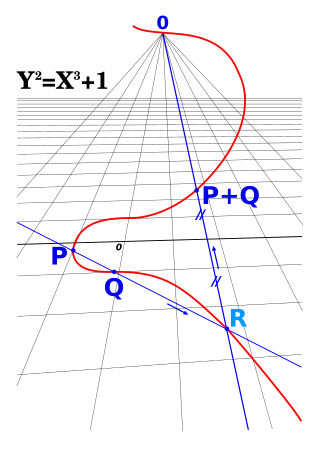
In algebraic geometry, a projective variety over an algebraically closed field k is a subset of some projective n-space over k that is the zero-locus of some finite family of homogeneous polynomials of n + 1 variables with coefficients in k, that generate a prime ideal, the defining ideal of the variety. Equivalently, an algebraic variety is projective if it can be embedded as a Zariski closed subvariety of .

David Bryant Mumford is an American mathematician known for his work in algebraic geometry and then for research into vision and pattern theory. He won the Fields Medal and was a MacArthur Fellow. In 2010 he was awarded the National Medal of Science. He is currently a University Professor Emeritus in the Division of Applied Mathematics at Brown University.
In mathematics, algebraic geometry and analytic geometry are two closely related subjects. While algebraic geometry studies algebraic varieties, analytic geometry deals with complex manifolds and the more general analytic spaces defined locally by the vanishing of analytic functions of several complex variables. The deep relation between these subjects has numerous applications in which algebraic techniques are applied to analytic spaces and analytic techniques to algebraic varieties.
In mathematics Haboush's theorem, often still referred to as the Mumford conjecture, states that for any semisimple algebraic group G over a field K, and for any linear representation ρ of G on a K-vector space V, given v ≠ 0 in V that is fixed by the action of G, there is a G-invariant polynomial F on V, without constant term, such that
In mathematics, a rational variety is an algebraic variety, over a given field K, which is birationally equivalent to a projective space of some dimension over K. This means that its function field is isomorphic to
In mathematics, the Kodaira vanishing theorem is a basic result of complex manifold theory and complex algebraic geometry, describing general conditions under which sheaf cohomology groups with indices q > 0 are automatically zero. The implications for the group with index q = 0 is usually that its dimension — the number of independent global sections — coincides with a holomorphic Euler characteristic that can be computed using the Hirzebruch–Riemann–Roch theorem.
A height function is a function that quantifies the complexity of mathematical objects. In Diophantine geometry, height functions quantify the size of solutions to Diophantine equations and are typically functions from a set of points on algebraic varieties to the real numbers.
In mathematics, specifically in algebraic geometry and algebraic topology, the Lefschetz hyperplane theorem is a precise statement of certain relations between the shape of an algebraic variety and the shape of its subvarieties. More precisely, the theorem says that for a variety X embedded in projective space and a hyperplane section Y, the homology, cohomology, and homotopy groups of X determine those of Y. A result of this kind was first stated by Solomon Lefschetz for homology groups of complex algebraic varieties. Similar results have since been found for homotopy groups, in positive characteristic, and in other homology and cohomology theories.
In mathematics, the irregularity of a complex surface X is the Hodge number , usually denoted by q. The irregularity of an algebraic surface is sometimes defined to be this Hodge number, and sometimes defined to be the dimension of the Picard variety, which is the same in characteristic 0 but can be smaller in positive characteristic.
In mathematics, canonical singularities appear as singularities of the canonical model of a projective variety, and terminal singularities are special cases that appear as singularities of minimal models. They were introduced by Reid (1980). Terminal singularities are important in the minimal model program because smooth minimal models do not always exist, and thus one must allow certain singularities, namely the terminal singularities.
In algebraic geometry, a vanishing theorem gives conditions for coherent cohomology groups to vanish.
In algebraic geometry, the Ramanujam vanishing theorem is an extension of the Kodaira vanishing theorem due to Ramanujam (1972), that in particular gives conditions for the vanishing of first cohomology groups of coherent sheaves on a surface. The Kawamata–Viehweg vanishing theorem generalizes it.
In algebraic geometry, the Kawamata–Viehweg vanishing theorem is an extension of the Kodaira vanishing theorem, on the vanishing of coherent cohomology groups, to logarithmic pairs, proved independently by Viehweg and Kawamata in 1982.
In commutative algebra, the multiplier ideal associated to a sheaf of ideals over a complex variety and a real number c consists (locally) of the functions h such that
In transcendental number theory, a mathematical discipline, Baker's theorem gives a lower bound for the absolute value of linear combinations of logarithms of algebraic numbers. The result, proved by Alan Baker, subsumed many earlier results in transcendental number theory and solved a problem posed by Alexander Gelfond nearly fifteen years earlier. Baker used this to prove the transcendence of many numbers, to derive effective bounds for the solutions of some Diophantine equations, and to solve the class number problem of finding all imaginary quadratic fields with class number 1.
In algebraic geometry, the Kempf vanishing theorem, introduced by Kempf (1976), states that the higher cohomology group Hi(G/B,L(λ)) (i > 0) vanishes whenever λ is a dominant weight of B. Here G is a reductive algebraic group over an algebraically closed field, B a Borel subgroup, and L(λ) a line bundle associated to λ. In characteristic 0 this is a special case of the Borel–Weil–Bott theorem, but unlike the Borel–Weil–Bott theorem, the Kempf vanishing theorem still holds in positive characteristic.
In algebraic geometry, the Ramanujam–Samuel theorem gives conditions for a divisor of a local ring to be principal.

Yujiro Kawamata is a Japanese mathematician working in algebraic geometry.
In algebraic geometry, Le Potier's vanishing theorem is an extension of the Kodaira vanishing theorem, on vector bundle. The theorem states the following
Le Potier (1975): Let X be a n-dimensional compact complex manifold and E a holomorphic vector bundle of rank r over X, here is Dolbeault cohomology group, where denotes the sheaf of holomorphic p-forms on X. If E is an ample, then
from Dolbeault theorem,
By Serre duality, the statements are equivalent to the assertions:
In algebraic geometry, the Bogomolov–Sommese vanishing theorem is a result related to the Kodaira–Itaka dimension. It is named after Fedor Bogomolov and Andrew Sommese. Its statement has differing versions:
Bogomolov–Sommese vanishing theorem for snc pair: Let X be a projective manifold, D a simple normal crossing divisor and an invertible subsheaf. Then the Kodaira–Itaka dimension is not greater than p.



